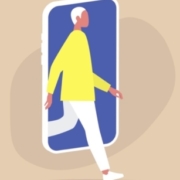
The sudden ubiquity of Zoom made me question my sanity.
When I’m on the phone listening to you, I concentrate on your voice and what you are saying. Similarly, as a speaker, I know I have my only my voice with which to communicate. I know the limitations of what I can and cannot convey with words only—without body language—and can happily function within those limitations.
During a face-to-face conversation with one or many, I can see bodies, facial expressions and even surroundings in context. Words are never out of sync with mouth movements. Neck-down body movements provide additional information that I can process along with your words.
For me, Zoom upends both of these understandings. People speak with the freedom of an in-person conversation, but without the context and visual cues that make in-person communication productive. Because your disembodied head is floating on a screen like the Great and Powerful Oz, my attention is bifurcated. It’s as if one part of me is watching your detached face as I would an ant dragging food back to the hive, and another part of me is trying to pay attention to the words (often out of sync) that are coming out of the mouth attached to the disembodied head. The effect is downright dissociative.
From a more practical perspective, I couldn’t take my usual copious notes during Zoom calls without appearing rude. The answer? Record the call so that I could double the time devoted to any one particular meeting—first sitting through the chaotic haze of faces and voices that comprised the zoom call, then listening to the whole thing all over again so I could actually absorb what was said.
Was I insane? Was this some new disorder kicking in? Happily, I discovered that I was not alone.
In an article entitled “The Reason Zoom Calls Drain Your Energy,” Gianpiero Petriglieri, an associate professor at Insead business school noted that “being on a video call requires more focus than a face-to-face chat. Video chats mean we need to work harder to process non-verbal cues like facial expressions, the tone and pitch of the voice, and body language; paying more attention to these consumes a lot of energy. ‘Our minds are together when our bodies feel we’re not. That dissonance, which causes people to have conflicting feelings, is exhausting. You cannot relax into the conversation naturally,’ he says.
In the same piece, Marissa Shuffler, an associate professor at Clemson University who studies workplace wellbeing and team effectiveness, observed that “if we are physically on camera, we are very aware of being watched. ‘When you’re on a video conference, you know everybody’s looking at you; you are on stage, so there comes the social pressure and feeling like you need to perform. Being performative is nerve-wracking and more stressful.’
USA Today talked with Jeremy Bailenson, the founding director of Stanford’s Virtual Human Interaction Lab about video conferencing, reporting that “the platforms naturally put us in a position that is unnatural. A combination of having prolonged eye contact and having someone’s enlarged face extremely close to you forces certain subconscious responses in humans.
“Our brains have evolved to have a very intense reaction when you have a close face to you,” he said.
For me, maximizing comprehension and productivity demands hiding all faces during Zoom calls and only viewing the screen when docs are shared. This lets me focus on and absorb what’s said. Zoom has clearly been incredibly valuable in handling the pandemic-caused workplace dislocation. Now, I think we all just have to learn how to best make it work for our own needs and individual work styles.
– Leonce Gaiter, Vice-President, Content & Strategy






